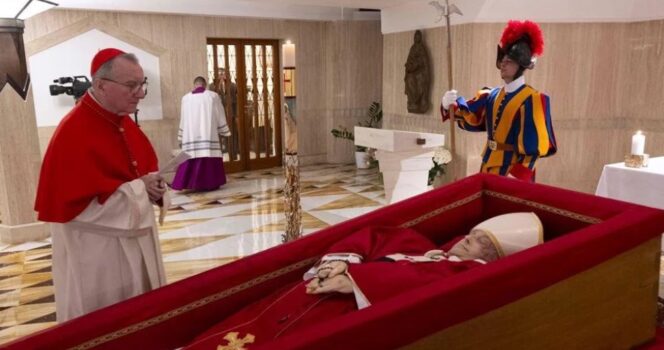A Final Testament: How Pope Francis’s Humble Farewell Redefines Papal Tradition
The images of Pope Francis lying in repose speak volumes — each detail of his final presentation offering a glimpse into the life and legacy of a pope who challenged convention.
From his unadorned coffin to the meaningful objects laid beside him, the late pontiff’s final resting display defies centuries of Vatican tradition — in accordance with his own wishes.
As the world says goodbye to Pope Francis, his burial will mirror the very principles he lived by: simplicity, humility, and deep compassion for the marginalized. His farewell is not just a ceremony, but a reflection of the values that defined his papacy.
The personal items chosen to accompany him serve as a final tribute to a life devoted to service, love, and transformation.

A Peaceful Passing
Pope Francis, beloved spiritual leader and global advocate for the poor, passed away on Monday at the age of 88 following a massive stroke and complications from pneumonia. He died peacefully at the Vatican, leaving behind a legacy of reform and empathy.
What Lies Within the Pope’s Casket?

On Tuesday, the Vatican released powerful images of the late pontiff lying in repose, surrounded by symbols that reflect his life and ministry.
In an open coffin watched over by ceremonial guards, Francis is dressed in red vestments — the color of martyrdom and Christ’s sacrifice. A rosary is folded gently into his hands, emphasizing his lifelong devotion to prayer.
Also placed in the casket are his mitre (papal hat), his crozier (pastoral staff), and coins minted during his time as pope — a tradition symbolizing the years he served as the Vicar of Christ.
A rogito, a sealed document summarizing his life and papacy, rests inside the coffin as well. On his right hand, he wears the Fisherman’s Ring — broken, as tradition dictates, to signify the conclusion of his reign and to prevent misuse after death.
A Simpler Resting Place

The coffin itself reflects the pope’s lifelong commitment to modesty. Forgoing the elaborate triple-layered caskets used for past pontiffs, Francis opted for a simple wooden coffin lined with zinc.
In another break from tradition, his body will not lie on a raised bier inside St. Peter’s Basilica. Instead, the coffin rests at floor level, facing the pews, with the Paschal candle — a symbol of Christ’s resurrection — nearby.
This choice offers mourners a more personal and intimate farewell, stripped of pomp and grandeur.
A Historic Departure from Vatican Grounds
In a decision not seen in over a century, Pope Francis will not be buried in the Vatican grottoes alongside his predecessors. Instead, he will be laid to rest at the Basilica of Santa Maria Maggiore in Rome’s Esquilino neighborhood — a place deeply meaningful to him.
Francis often visited the basilica to pray, and he had expressed his desire to be buried there, underscoring once again his devotion to simplicity and personal connection.
Funeral and Final Rites
The Vatican has announced that the funeral Mass will be held on Saturday, April 26 at 10 a.m. local time in St. Peter’s Square.
Beginning Wednesday, Pope Francis’s body will lie in state inside St. Peter’s Basilica, where mourners will pay their respects. As the procession enters, the Litany of the Saints will echo through the basilica, led by the Camerlengo, Cardinal Kevin Joseph Farrell — a papal appointee from 2019.
A Legacy Etched in Humility
While the world continues to grieve the passing of Pope Francis, it’s the quiet details — the wooden coffin, the absence of grandeur, the choice of burial site — that most poignantly reflect the man he was.
In death, as in life, Pope Francis chose humility over splendor, compassion over ceremony. And in doing so, he may have reshaped how the world views papal legacy — not through golden processions, but through grace, empathy, and simplicity.



